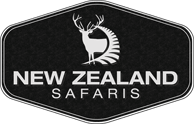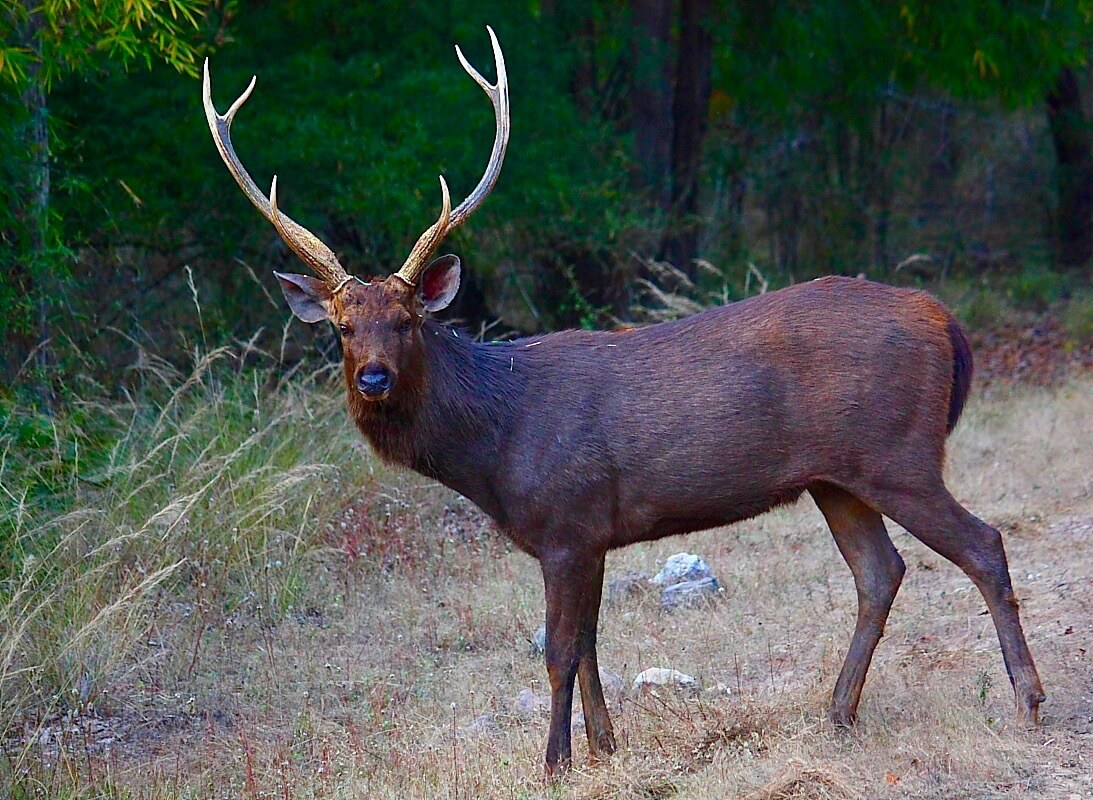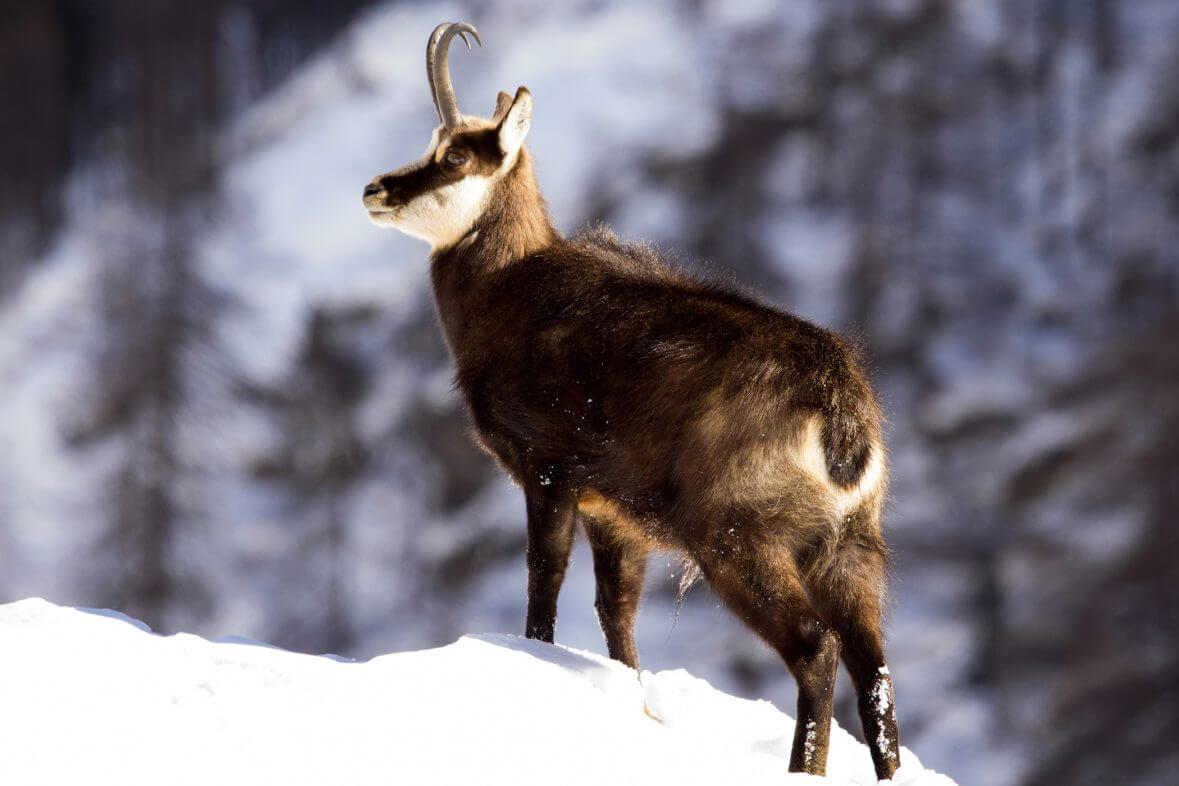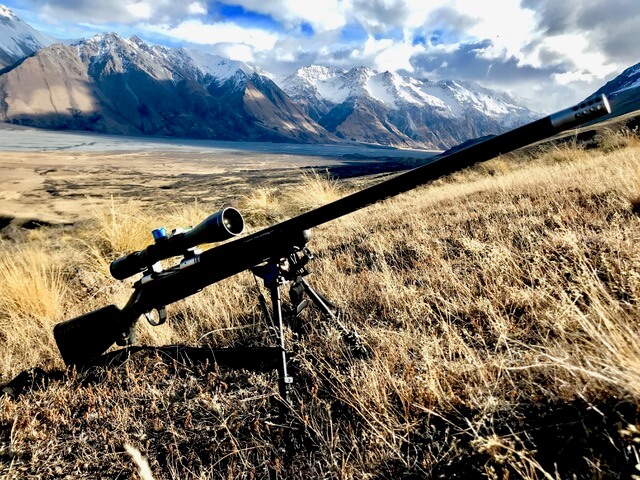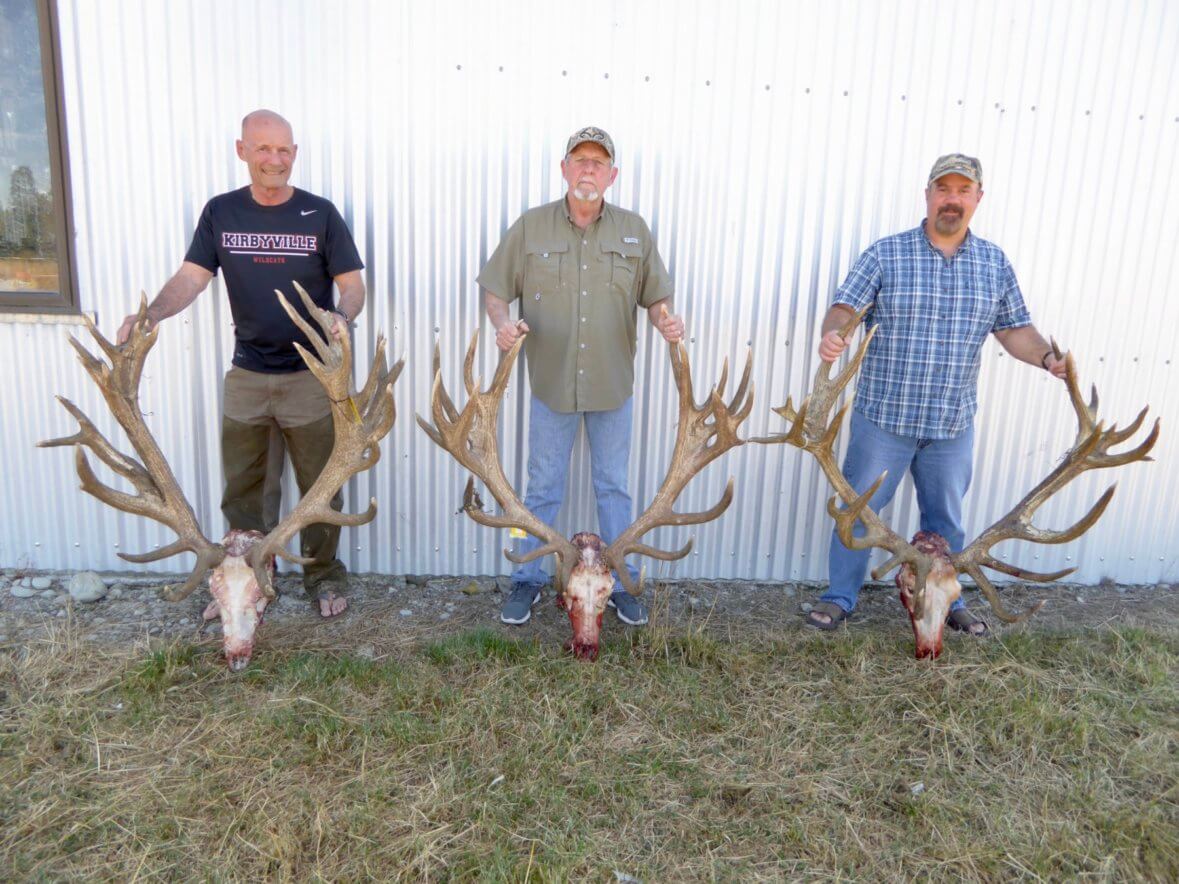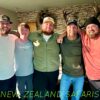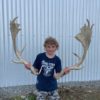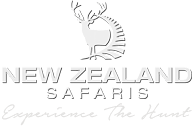In New Zealand, sambar deer (Cervus unicolor unicolor) are considered an ‘iconic herd’. They are only in the North Island and mostly on private land.
Sambar can be a difficult deer to hunt. As with all hunting the more you can learn about the quarry and the area to be hunted the better the chance of success.
Description:
Size: Males average 1370 mm shoulder height and 245 kg in weight with females smaller at 1150 mm shoulder height and weighing up to 157 kg.
Colour: Uniform brown darkening to almost black in older animals with tan to rust red on the rump. Under parts grey to mid brown.
Antlers: Thick, heavily pearled and normally three tined (brow and trez tines and a terminal tine at the end of the main beam). Antlers cast November to December with new ones grown January to March hardening between June and November.
Social behaviour: Males solitary except during the rut. Young males and females form small groups of 2-5 animals. Feed mainly at night and during the day seek shelter in scrub or forest cover. Form complex trail systems accessing feeding areas from day time cover
Reproduction: The rut can happen any time between late May and December with June to August the usual period. The females, attracted by noise and scent, visit the male for a short period until mating takes place. (Harems are not formed.) Males are not particularly vocal during the rut but are known to emit a short harsh belling noise which is rarely heard by hunters.
Gestation period: Approximately 240- 264 days.
Birthing: March-April or July-September.
Nomenclature: Male = stags. Female = hind. Young = fawn/calf.
Where to hunt
In New Zealand sambar deer are only found in the North Island.
The two main populations of wild sambar deer are found in the Manawatu/Wanganui region and the Bay of Plenty region. Their range in both these areas is mostly on private land – mainly forestry blocks. New Zealand Safaris has exclusive hunting access to some of the most sought after sambar deer properties in the country.
Sambar occupy a variety of habitats from indigenous and exotic forests to wetlands and farmland.
Hunting Tips:
| Characteristic/behaviour | Hunting response |
|---|---|
| Large bodied animals (mature stag 400-500 llb andstand 60+ inches at the shoulder) | A larger rifle calibre with high energy is recommended with Sambar Stags deer known to absorbed shots. Suitable calibers include .270, 7mm, 300 win. |
| Although tending to be unpredictable, within a hunting area sambar will have preferred spots for feeding, hiding etc. | Learning as much as you can about the area being hunted will greatly increase the chances of success. |
| Elusive animals with the ability to exit within close proximity to people without being detected. Often won’t break until a hunter is very close and sometimes crawl rather than run. Can hide in very small patches of vegetation. | Hunt slowly, stopping often and surveying all around. Don’t discount the smallest of vegetation patches eg small clumps of gorse. |
| Once spooked sambar usually won’t go far and as retreating can often be heard making a trumpet like noise. | Listen to retreating animal to gauge where it is heading and after a short time follow. |
| Sambar feed primarily early morning and late evening utilising the cover of darkness but can be found feeding during the day using vegetation cover. | Late evening and early morning hunting is likely to find deer out in the open where as day time hunting will likely find deer in amongst thick vegetation. Hunt the change of light on dark nights. |
| Sambar are attracted to crops for feeding. | New Zealand Safaris hunts exclusively on private free ranging land like that has this feed. |
| Sambar Deer Rut New Zealand | Sambar deer’s main rut is from late May-September, and at times longer. |
| Sambar are very alert to foreign sounds. | With the wind in the right direction stake out feedings areas and wait for sambar to come to you. |
Chamois (Rupicapra rupicapra rupicapra) are found throughout the high country of the South Island and in some lowland forests, from the Marlborough Sounds in the north to Fiordland in the south.
They are renowned for their ability to occupy a range of mountain habitats, and will spread into lower altitude forest areas especially on the West Coast.
Description
Size: Males Bucks are 650-900 mm (shoulder height) and weigh 55-100 lb. Females are smaller at 600-800 mm shoulder height and weighing 41-55 lbs.
Colour: Their summer coat varies from grey-brown, tan to honey-gold tone. Their much darker winter coat is dark brown/almost black.
On their face they have a dark brown or black band that goes from the nose, around the eyes to base of horns. Their cheeks and throat are white or pale fawn.
Horns: Both male and females have horns which are black and slender. They arise straight up before curving backwards to form sharp hooks at the ends. Male horns are usually stouter and their hooks more strongly developed than females.
Social behaviour: Mostly feeding during the day, during summer time they feed for 3-4 hours from dawn and again for 3-4 hours before dusk. They rest during the middle of the day. During winter they feed less intensively, mostly at mid morning and mid afternoon.
Outside of mating season, male and female chamois are largely segregated. Females and young form loose, unstable groups, and males are mostly solitary.
Reproduction: Mating season begins in early-mid May, peaking in late May to early June. During this time dominant males will gather available females in a harem, defending them from other males often posturing with imposing displays but rarely resulting in frontal attacks.
Gestation period: Variable 5 1/2 to 6 months.
Birthing: Single young are born from November to February.
Nomenclature: Male chamois are called bucks, females called doe, and there young called kids.
Where to hunt chamois
Chamois are found throughout the high country of the South Island and in some lowland forests, from the Marlborough Sounds in the north to Fiordland in the south.
They are renowned for their ability to occupy a range of mountain habitats, and will spread into lower altitude forest areas especially on the West Coast. New Zealand Safaris has exclusive hunting access to private land areas which do not require the use of helicopters. Beaches these areas and managed with a maximum of 2 Bucks per property there are very good numbers and older animals with no pressure from local hunters.
The right rifle caliber for hunting in New Zealand is wide open, that is like asking what kind of truck do you like to drive, or beer do you drink. New Zealand Safaris tested the latest Christensen Arms Ridgeline out for the 2019 season in 7mm mag using Hornady hand loaded 175g ELD-X.
We typically shoot at distances between 200-400 yards depending on clients confidence, animals, weather, ect. These longer shots are more taken on our free ranging and wild animals such as Red Stag, Tahr, Chamois, Sambar Stag and Fallow Buck. Red Stag, Tahr and Sambar Stag are extremely heavy boned with thick hides especially the Tahr so suitable rifle caliber for hunting in New Zealand must be able to deliver the energy down range with precision accuracy for fatal shot placement.
We now have more demand from clients to use our rifles so lighter in weight has become more important, as we also have a bipod on the front of the rifle and often suppressors to take recoil and reduce the noise. All of our hunting is on private land so we like to manage the habitat for the game to help get our clients onto those older mature animals. Obviously that is unique to our private land properties, you will not find that on government land where animals are constantly getting shot at or from above by way of helicopters.
We used the Christensen Arms Ridgeline rifle on one hunt that included 3 animals in winter so all the coats were heavy. The longest shot was a free ranging Chamois, or mountain Antelope. These are by no means heavy skinned but very small in size with an up hill shot at 370 yards the Hornady Bullets held together perfectly and the shot was fatal instantly and made very little damage to the hide.
The Tahr also was 365 yards as the hunter had confidence in this rifle and we had zero wind, on a cooler winter morning we were shooting across from one ridge to another. Although the animal ran out of sight it fell some 60 yards behind the ridge with the bullet lodging out the outer side just under the heavy skin.
The Red Stag was 320 yards and in an opening of heavy timber. With light weight rifles like the Ridgeline you can move about more freely as every pound counts on mountain hunts. The quartering shot went in behind the front shoulder and exited on the inside front should, the stag stood briefly with a second shot as insurance it was over.
After using a variety of bullets such as Berger, Barnes and sSwift I have found the latest Hornady 175g projectiles to be well suited all round for our game. This was the first Christensen Arms rifle we have owned and we’re very impressed with its performance. Topped with a Huskemaw Optics Dial Scope this is a great fit for our New Zealand Safaris clients.
A Tahr (Hemitragus jemlahicus) are large goat-like animals, native to the central Himalayan ranges of India and Nepal. In New Zealand tahr are found in the central Southern Alps between about the Rakaia and Whitcombe valleys in the north to about Lake Hawea in the south. The main population today of Tahr still exist around the Mt Cook area in the central South Island.
Tahr are also known as and called Himalayan Tahr. Tahr are originally from Nepal they were gifted to New Zealand over 100 years ago for sport They have found the Southern Alps of the South Island ideal habitat. The Himalayan Tahr was introduced to the central South Island of New Zealand. Specifically the Mt Cook area which also happens to be the home of New Zealand Safaris.
Tahr are generally found in the alpine grassland zone, where they graze on snow tussocks, alpine herbs and sub-alpine shrub-land plants.
The male tahr’s summer coat is a reddish-brown, females a medium brown, both turning dark brown in winter. The bull tahr has an impressive mane of long hair around the neck and shoulders.
Tahr are popular with recreational and international hunters for their horns, the male’s striking mane, and for the experience of this mountain like goat hunt.
Tahr are social animals and form easily recognisable groups. Adult females, yearlings and kids gather together, males over 4 years form bachelor groups, and younger males hang out together in separate, smaller groups. Males mix in with the females in their range over the winter breeding season but during the summer months they often travel long distances away from the female groups. A mature male is considered 6 years or older which you can count by his rings on his horns which is a trophy Bull. Tahr can be hunted both on government land or private land. With the culling operations that are presently happening hunters after a quality experience have now learnt that private land is far more successful in taking mature trophy Bulls with a recognised outfitter like New Zealand Safaris, over hunting against other hunters and helicopters on public lands in the same areas.
A male Bull Tahr can weigh up to 300 pounds and will hold up to 50 nannies and kids during the rut. The tahr rut normally happens in May-July. Bull Tahr will get older and will have longer horn growth when then inhabit privately owned, free range areas where the hunting is well managed. These animals have the ability to come down to lower areas to feed on sweet grasses unlike the tahr you will find on public or government land.
Today Tahr are found along the Southern Alps of the South Island but more specifically centralised in the middle part of the South Island still today in the Mt Cook, Mackenzie region.
One of the most common questions we hear is, how much is a red stag hunt in New Zealand? There are lots of factors that will effect the price of a red stag hunt – public or private land, professional outfitter or DIY, size of the animal, accommodations to name a few. Most Red Stag hunts with professional outfitters will start around USD $5500 per hunter in 2 hunters x 1 guide. This will often include 5 days of hunting, 4 nights of accommodation and trophy fees for 1 Red Stag up to 350 inches or 1 wild and free range Red Stag.
So how much is a red stag hunt at At New Zealand Safaris? Our base Red Stag hunts starts at $5500 which is conducted all on privately owned land, where we have exclusive hunting rights.
As you research you will find Red Stag hunt prices in New Zealand can vary depending on the hunting outfitter and quality and experience of the hunt someone is looking for.
If you are interested in larger stags or combination packages please contact us.
